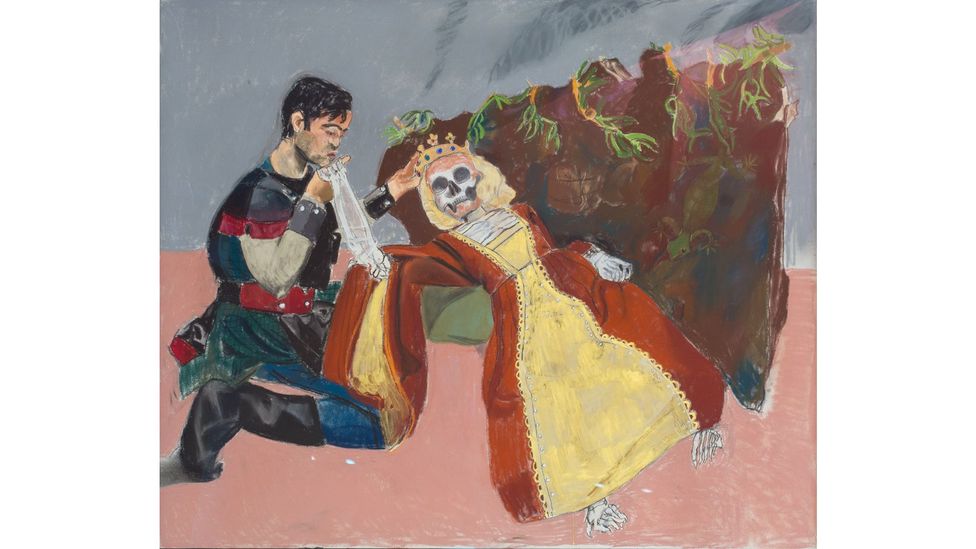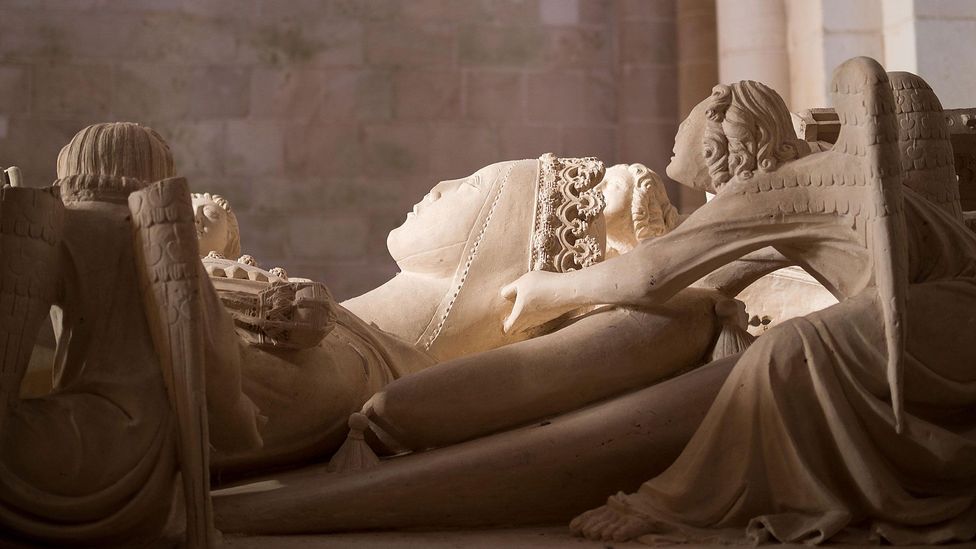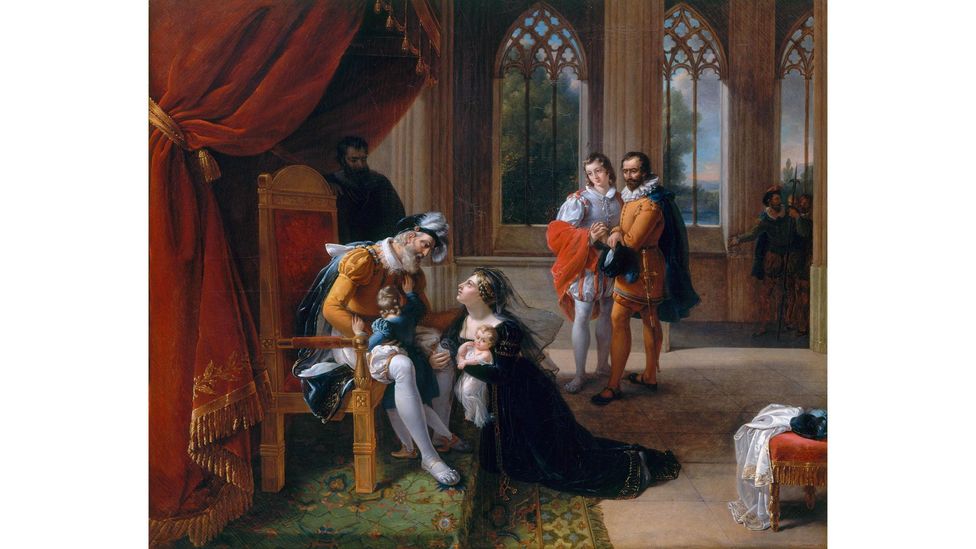A love story with a horrifying end

It’s a tale as old as time – two lovers unjustly torn apart. But while the story of King Pedro I and his queen Inês De Castro has shades of Romeo and Juliet in its set up, it ends up somewhere altogether more macabre – imagine if Shakespeare’s tale swerved into horror movie territory in the final act.
More like this:
– Is Paula Rego the UK’s greatest living artist?
– The woman written out of history
– The princess who thought she was made of glass
Based on a true tale from medieval Portugal, the Pedro and Inês myth is one of the most frequently adapted historical stories of all time – and no wonder. It really does have the lot, from passionate young love to the coronation of a corpse. The artists it has inspired include the great Paula Rego, whose 2014 portrait Inês De Castro was painted as a commission for the Women’s Art Collection at Cambridge University’s women-only Murray Edwards College. The collection is the largest of women’s art anywhere in Europe, with more than 600 artworks, by artists including Maggi Hambling, Lubaina Himid and Judy Chicago, many of which can be seen from today in an exhibition at the London Art Fair, Myth-Making and Self-Fashioning. Rego’s work, which she painted to mark the collection’s 60th anniversary, should prove a particularly unsettling highlight, with its depiction of Queen Inês – a skeleton.

Like much of Paula Rego’s work, her portrait of Inês both captivates and unsettles (Credit: The Women’s Art Collection, Murray Edwards College/Paula Rego)
To go back to the story’s foundations, the following is believed to be broadly true, taken from an chronicle written by the Portuguese historian Fernão Lopes around 1440: in around 1340, Prince Pedro I fell in love with his wife’s lady-in-waiting, Inês de Castro, whose father was a Spanish nobleman. Pedro’s father, the Portuguese King Afonso IV, did not approve, and exiled Inês. But after Pedro’s wife died, Inês returned to Portugal and lived with Pedro, and they had four children.
Afonso and his advisers were not happy, and in 1355 Afonso decided Inês’s presence was too much of a political risk to the royal Portuguese line, and had her killed. She was buried in the city of Coimbra, while Pedro swore revenge, and led an uprising against his own father, kicking off a civil war within Portugal. When Pedro then took the crown, after Afonso’s death in 1357, he then tracked down Inês’s two assassins, and ripped out their hearts.
Pedro also vowed to make Inês queen of Portugal, even in death. Grand tombs were crafted for them both, at the monastery of Alcobaça – and in 1360, several years after her death, Pedro dug up Inês’s decomposing body and grandly took it in a procession from Coimbra to Alcobaça, where it was royally entombed, so that he would eventually be able to rest opposite her in death, always.
That in itself is a grimly astonishing story – but as it was reshaped into a widely re-told myth, it was made even darker, with the story’s unnerving ending extended to include a rather more literal take on the idea of crowning a dead queen. A key early instance of this was in Spanish playwright Jerónimo Bermúdez’s 1577 tragedy Nise Laureada, where Inês was not merely transferred to a new tomb, but her corpse was treated to a whole coronation ceremony.
From then on, the scene of a mad king insisting his lover’s rotting body be dressed in coronation robes, propped up on a throne, crowned, and her hand kissed by noblemen, has proved irresistible to most adaptors, forming a grotesque set piece for scores of plays, poems, paintings, operas and novels.
It is this moment, too, that is captured by Rego. Her painting shows Inês as a sprawled skeleton, but dressed in gold and carmine robes, having her hand kissed by Pedro and a crown placed on her head. The viewer has the strange sensation of being eyeballed by the dead queen, and the image, like much of Rego’s work, both captivates and unsettles.
“Paula is so interested in instances of violence against women, and it’s a very tragic and visceral example of that,” says the curator of the Women’s Art Collection, Naomi Polonsky. “But also, she’s interested in folk and fables, so there’s that element as well. [The story of Inês] lends itself to very striking imagery – you can’t walk by a skeleton in regal dress without stopping and thinking ‘what’s going on there?'”
How the story became a myth
This macabre fascination has surely driven much of the interest in Inês, but the story has been interpreted in many ways. It offers a site for exploring all kinds of themes: love and devotion, innocence and injustice, politics and war, madness and obsession, death and grief, femininity and masculinity.

Inês’s body was exhumed by Pedro and she was entombed at the monastery of Alcobaça – where he lies next to her (Credit: Alamy)
“Because there are so few historical documents from the time, artists have a lot of leeway,” says Aida Jordão, a Portuguese-Canadian academic and theatre practitioner at the University of York in Toronto who has extensively researched presentations of Inês de Castro. “Artists can invent and reinvent, and add to what I call this palimpsest of Inês de Castro: the new versions are written over the old stories.”
And it really is hard to overstate just how famous and foundational this story is in Portugal. “It is in our collective memory,” says Jordão, who was born in Lisbon. “Most Portuguese schoolchildren are introduced to the story at fourth or fifth grade; my nephew played the assassin in the school play! This is very common, although the story is cleaned up.”
Portuguese teenagers will also encounter Pedro and Inês when studying their national poet, Camões, at school, usually focussing on the episode in which they feature from his epic 1572 poem Os Lusíadas. “Camões is hugely responsible for the story being such an iconic representation of Portugal,” says Jordão, adding that it was Camões being translated into other languages that “took Inês out of Portugal and into Europe”.
Although their myth is less well-known in English-speaking countries, its reach is nonetheless huge: a recent academic work, José Pereira da Costa’s Inês de Castro, Musa de Tantas Paixões, has a bibliography which cites a mind-boggling 5,531 works about Inês de Castro. And what’s particularly notable is that the story has been fictionalised with a persistent, consistent regularity across the centuries.
“What amazes me is the constant production of work,” says Jordão. “It’s continuous – people are always producing her story, in every means imaginable.”
The earliest Portuguese play – António Ferreira’s Castro, written in 1556 – was recently revived as a modern-set production at the Teatro Nacional São João, Porto; in response, the theatre also staged last summer a new version of the play called Kastrokriola, by Caplan Neves, a playwright from Cape Verde. This reimagined the myth by making it a lesbian love affair – a way to make their love affair carry shock-value in a contemporary Cape Verdean setting.
Some versions, however – including, of course, the family-friendly ones – seek to smooth over the more shocking elements of the story – a glossing-over that was occurring as early as 1637, when Spanish playwright Luis Vélez de Guevara speeded up the story’s timeline in his tragedy Renair Después de Morir. In that version, Pedro’s revenge and his coronation of his queen happen with 24-hours of her murder, rather than after several years. “What does that do? Beautiful corpse,” says Jordão. The romance of the story remains unsullied.
Through the 17th and 18th Centuries, Pedro and Inês made their way steadily across Europe. Unsurprisingly, their doomed love has formed a popular basis for operas, in Italian, English and German. And in 1843, Inês was the subject of a painting by the Russian artist Karl Bryullov, showing her pleading for her life on her knees, dressed in white in a world of dark rich reds and browns, clung to by two tiny children: the ultimate picture of innocence.

This 1822 painting by French artist Eugenie Serveries depicts Inês pleading for mercyat the feet of King Afonso (Credit: Alamy)
By the 20th Century, Inês was cropping up in the US poet Ezra Pound’s Cantos, and the story also made its way to the screen: there have been three films, and a TV series, all in Portuguese, since 1945, the most recent released in 2018. Pedro e Inês – or The Dead Queen in English – was directed by António Ferreira, and based on the 2001 novel A Tranca de Inês (The Braid of Inês), by Rosa Lobato de Faria, an actor and writer (who has also written the lyrics for several of Portugal’s Eurovision Song Contest entries, incidentally).
Her book imagined a contemporary Pedro in a psychiatric unit, unable to distinguish between memories from three different time-periods. The book – and film – flash between the classic, medieval version of Pedro and Ines’s story, an updated contemporary version and a third set in a futuristic, post-climate catastrophe world.
A very modern retelling
I speak to Ferreira from his home in Coimbra – the site of Inês’s murder, of course. When asked about the appeal of the story, he gives a surprisingly nonchalant answer. “I’m from Coimbra, and it’s really everywhere – Pedro and Inês bread, Pedro and Inês wine, whatever. So as someone who grew up with this, it’s actually not so interesting. You get bored.” But then his cousin and eventual fellow adaptor, Glória Ferreira, told him to read Lobato de Faria’s book, thinking it would make a good film… and he became hooked by the possibility of an unexpected re-telling of this overly-familiar story.
“I thought, yeah, actually – it’s a completely fresh approach to the theme, with present, past, future.” While Ferreira includes classic scenes within the Middle Ages section – the tearing out of the hearts; noblemen gagging as they have to kiss Inês’s decomposing hand – Pedro e Inês also features a contemporary architecture studio and a jealous wife, and a dystopian vision of a self-sufficient rural community with strict rules around procreation.
For Portuguese audiences, the story is so well-known as to be able to be endlessly riffed on – rather like the way Romeo and Juliet has inspired everything from West Side Story to Gnomeo and Juliet. Indeed, Jordão even shows me a children’s picturebook called Nero e Nina by Mário Claudio, telling the story from the point of view of the lovers’ dogs – Pedro’s loyal mastiff and Inês’s elegant whippet, pets that are carved on their tombs.
Given the legend’s reach, longevity and rich mixture of romance and horror, however, it seems slightly mysterious that it’s not yet better known outside Portugal. It sounds absolutely ripe for a blockbuster movie or a lavish, Game of Thrones-style series.
“The question is, why don’t people know Inês? My students never know her,” Jordão acknowledges. She has an unsentimental theory: “It is compared to Romeo and Juliet. Romeo and Juliet is a masterpiece. Perhaps the masterpiece about Inês has not been written yet – or not been universalised.”
Still, there have been some notable versions of the story across the globe. As early as 1688, English playwright Aphra Behn translated a French version of the tale into an English novella. This was then adapted for the stage by another woman, Catharine Trotter, and played at Drury Lane in 1696. Titled Agnes de Castro, its plot had already wandered a fair way from the original, introducing new characters as part of a complex plot that becomes about the perils of female rivalry and jealousy.

The opera Inês de Castro is a graphic and harrowing portrait of femicide (Credit: Getty Images)
Meanwhile, one of Jordão’s favourite adapations of the story is 2009’s Tale of Coimbra, by the Takarazuka Revue: an all-female theatrical company, founded in Japan in 1913, that perform extravagant musical productions where women play the masculine roles. “They set the story in pirate times – so Inês has a pirate double!” says Jordão gleefully.
A recent, notable English-language outing for the story was James MacMillan’s controversial opera, Inês de Castro, which was first performed at the Edinburgh International Festival in 1996, and then revised and revived for Scottish Opera in 2015. It has a libretto by Scottish playwright Jo Clifford, who first told Inês’s story as a straight play at Edinburgh’s Traverse theatre in 1989. She refuses to sentimentalise this story of femicide, telling “the story of how women are used as pawns in games of war,” says Jordão.
On Clifford’s website, she recalls that a review of the original production in The Observer called the opera “a piece of pornography” and suggested it should be banned, adding “it’s a review I am very proud of”. More recent responses were less absolute, although The Guardian called the 2015 revival, set in a contemporary political dictatorship, “harrowing – almost unremittingly, sometimes salaciously. MacMillan’s score simmers, shrieks and keens [and] Clifford’s unflinching libretto contains graphic depictions of sexual violence, infanticide and torture… It isn’t an easy watch, but it isn’t supposed to be.”
Jordão’s research is explicitly interested in the character of Inês, her agency, and in feminist versions of the story – of which, I assume, there must be many. Not so, apparently: she cites Clifford’s work in this direction as still being quite rare. While some early plays – Ferreira’s Castro; Vélez de Guevara’s Reinar Después de Morir – do put Inês at the centre, Pedro then took precedence in most subsequent retellings.
“The story becomes about him – how he declares civil war, how he tortures assassins, how he takes Inês from her resting place…” says Jordão. “Even in children’s stories and popular culture through the 20th Century, the sentimental femininity and passivity of Inês is totally played up. She’s described as someone who’s beautiful, but does nothing.” It is partly through frustration at this that Jordão has written her own play, I, Castro, which will have a staged reading this summer, which puts Inês in conversation with other ignored women in the narrative, such as her sister and Pedro’s daughter.
The dial on this may be changing, even if slowly, however. Inês’s most recent high-profile outing – Inês de Castro, a historical novel by the Portuguese writer Isabel Stilwell, published last October – certainly aims to give her influence. Its tagline is “Spy, lover and Queen of Portugal”, and this Inês is a player, rather than a pawn, in the game of political chess: “an agile spy who moved the pieces on the board of power,” as the blurb puts it.
Such interpretations inevitably lead us back to the Rego painting – another work that puts Inês firmly centre-stage, however darkly. “It shows Rego’s feminist vision of the world, in which women are dominant – or not subservient, at least,” says Polonsky. “[Rego] talks a lot about subverting hierarchies, and in that painting, Inês is very much the main character. She dominates the composition even though she’s a corpse.”
Just as it should be, perhaps, in this story of a dead queen who just won’t be forgotten.
Myth-Making and Self-Fashioning is at the London Art Fair, 20-24 April; The Women’s Art Collection is open daily at Murray Edwards College, University of Cambridge. A staged reading of Aida Jordão’s play I, Castro will be performed at the conference Women, Gender and Intersectionality in the Lusophone World, 29 June 2 to July, Ponta Delgada, Portugal.
Holly Williams‘s novel What Time is Love? will be published by Orion on 26 May.
BBC Culture has been nominated for best writing in the 2022 Webby Awards. If you enjoy reading our stories, please take a moment to vote for us.
If you would like to comment on this story or anything else you have seen on BBC Culture, head over to our Facebook page or message us on Twitter.
And if you liked this story, sign up for the weekly bbc.com features newsletter, called The Essential List. A handpicked selection of stories from BBC Future, Culture, Worklife and Travel, delivered to your inbox every Friday.








